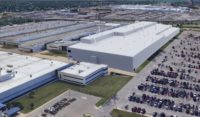

After years of fits and starts, Los Angeles' Exposition Light Rail Line is set to open on April 28. Though incomplete, the first section, which connects the city's west side to its downtown, is a milestone in a 50-year saga.
"The Expo line will serve a highly congested east-west corridor, providing the only rail alternative to the west side of Los Angeles," an L.A. Exposition Construction Authority (ECA) spokesman tells ENR. "Once operational to Santa Monica, it is expected to be one of the most heavily used light-rail lines in the nation, with more than 64,000 passengers per day."
The $930-million phase-one project, built by a design-build team of FCI, Fluor and Parsons, has withstood a staggering amount of delays, excess expenditures and controversy since breaking ground more than seven years ago. The section is scheduled to open without service to the Farmdale and Culver City stations, which are still under construction and scheduled to be completed later this summer.
The latest budget analysis forecasts a shortfall of $2.9 million for "cost elements that are known or anticipated at this time." Significant scope changes were made to the project after the award of the contract, including the locations and designs of the rail yard and maintenance shops, ECA says.
"Two stations were also added, and the design on the west end of the project changed from an at-grade interim station to an elevated station on a large aerial structure crossing three streets," ECA explains. "There were significant utility relocations, primarily from overhead to underground, the timing of which was beyond [ECA's] control."
There are seven more miles to go. The primary design-bid-build winner of phase two—a $1.5-billion section from Culver City to Santa Monica—is a joint venture of Skanska USA West and L.A.-based contractor Rados Construction Inc., with designer Parsons Brinckerhoff. The entire line spans 15.2 miles of double track along 19 stations.
The phase-two team, awarded the job last March, has completed other transit projects together. "Our relationship with Steven Rados goes way back, and we’ve done a lot of transit work with PB, mostly in the New York market," says Michael Aparicio, civil executive vice president of the Skanska unit. "BP has done an excellent job of delivering the design, which is about 85% complete, on time," Aparicio adds.
Court Challenges
Legal disputes are one of the primary risks of the project, experts say.
"All of the public-works departments and utilities have to be coordinated," says Aparicio. "All of the dry and wet utilities have to be identified and moved out of the rail corridor. If you have not captured a plan, then that can cause construction delays."
On April 18, California's 2nd District Court of Appeal sided with ECA against a community organization, Neighbors for Smart Rail, which on environmental grounds sued to stop progress of phase two on a section of the 6.6-mile line. It was the latest episode in challenges from several entities disputing eminent domain and environmental impact claims of the Expo project. Further, several school districts and municipalities have quibbled about the safety and even the cosmetic details of the project.
On the flip side, the historic program aims to alleviate the city's transportation bottlenecks.
"The Santa Monica Freeway is jam-packed everyday, all day," says Rick Jager, spokesman for the L.A. Metro Transit Authority. "Hopefully, this alleviates some of the automobile congestion in that part of the city and has some environmental benefits as well."
The Expo phase-two contract is worth about $560 million for Skanska. "It was very important project for us as we position ourselves as a major transit builder in the west," Aparicio says. "We pursued it for about 18 months—it was a major target."
The Venice Boulevard Bridge, which will keep Expo trains from crossing traffic just past the Culver City Station, is one of the first orders of business for phase-two construction. The $15.3-million work is under contract to Balfour Beatty Infrastructure; Parsons Transportation Group is the designer. The only remaining contract will be for a yard and shops.
"It will be a design-bid-build project with an expected advertising date of early next year," ECA says. "The design team, Maintenance Design Group, is currently about 60% complete."
In light of L.A.'s precarious financial situation and a phase-one budget shortfall, do Skanska and others have reason to be nervous? "The [owner] has a more than adequate budget for phase two," Aparicio comments. "We don’t expect any overruns."
The largest expense for both phases is construction, at about $1 billion, followed by right-of-way acquisition, at about $280 million. The purchase of vehicles costs roughly $250 million.


Post a comment to this article
Report Abusive Comment